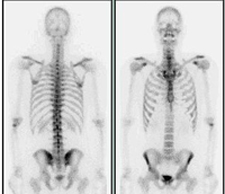 A gallium scan is a nuclear medicine test that uses a special camera to take images of specific tissues in the body. Several days before the test is performed, a radioactive tracer is injected into the body through a vein in the arm. Over the next 2-3 days, the tracer travels through the body and builds up in locations where there is a build-up of white blood cells.
A gallium scan is a nuclear medicine test that uses a special camera to take images of specific tissues in the body. Several days before the test is performed, a radioactive tracer is injected into the body through a vein in the arm. Over the next 2-3 days, the tracer travels through the body and builds up in locations where there is a build-up of white blood cells.
On the day of the test, patients go to the radiation department of the hospital for this test. Patients lie on their backs for the first part, or sometimes all, of the scan. A large camera will be positioned close to the body and move slowly above and around the body. The camera does not release any radiation, but it is searching for radiation being released from the tracer in the patient’s body. Patients may be asked to move into a few different positions, and need to lie very still in each position. Because of this, children may be sedated for the test. Gallium scans take between 45-90 minutes to complete.
After the scan, the images are sent to a radiologist who reads them and reports back to the patient’s doctor. The radiologist is looking for places where the tracer has “built-up,” which is due to either infection, inflammatory disease or a tumor.
